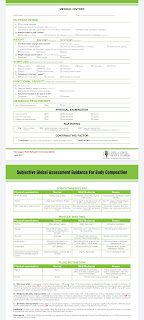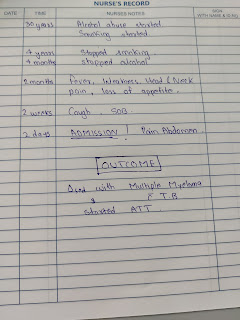INTERNAL ASSESSMENT Bi monthly
1) anatomical diagnosis -? Kidney ? Cardiac?? Liver??? Etiological diagnosis - ?? Nephrotic syndrome secondary to the diabetic nephropathy or CKD.
2)Reasons for I) Azotemia : impaired renal excretion of urea and creatinine secondary to CKD.
II) Anemia : decreased erythropoietin.
III Hypoalbunemia: capillary basement membrane and podocytes damage.
IV) acidosis: acidification of urine is lost.
3) Rationale : syp potchlor was given because of the hypokalemia.. Inj. NaHCO3 was given because of metabolic acidosis ..Insulin and antihypertensives are given because known case of DM and HTN. Orofer XT was given because of anemia.. Inj. Lasix was given to decrease her volume overload. Spironolactone was given it was a potassium sparing diuretic.Calcium was given to the patient because of hypocalcemia secondary to CKD. Indications of NaHCO3:metabolic acidosis in cardiac arrest, Tricyclic antidepressants, aspirin and phenobarbitone overdoses, Hyperkalemia, Crush injuries, C/I in certain conditions because of adverse reactions like Hypernatremia, metabolic alkalosis, cellulitis, seizures, Tetany, sodium retention, peripheral edema.
https://www.ncbi.nlm.nih.gov/pmc/articles/PMC4227445/
4) indication of dialysis in this pt: worsening of SOB secondary to metabolic acidosis with Anuria not resolved with high ceiling diuretics...Crucial factor: pt became symptomatic on 3rd day....
5) Causes of same condition : primary : Minimal change disease, Focal segmental glomerulosclerosis, Membranous nephropathy. Secondary : DM, SLE, HIV , Viral hepatitis, malaria, amyloidosis, Sarcoidosis, Drugs : Nsaids, gold, pencillamine Cancer: Hodgkin's and non Hodgkin's, solid tumours of GIT, RCC and lung.
6) Patients with CKD and hypoalbuminemia had had a high mortality rate
https://www.ncbi.nlm.nih.gov/pmc/articles/PMC7031689/
7) In CKD, hypertension and vascular changes have known to lead to HFpEF
https://www.ncbi.nlm.nih.gov/pmc/articles/PMC6737277/
8) Placebo controlled randomised trial of Enarodustat in CKD with anemia patients :
Roxadustat transiently and moderately increased endogenous erythropoietin and reduced hepcidin. Adverse events were similar in the roxadustat and placebo groups. Roxadustat produced dose-dependent increases in blood Hb among anemic NDD-CKD patients in a placebo-controlled trial.
https://pubmed.ncbi.nlm.nih.gov/26238121/
10)PROTEIN ENERGY MALNUTRITION-.Roxadustat transiently and moderately increased endogenous erythropoietin and reduced hepcidin. Adverse events were similar in the roxadustat and placebo groups. Roxadustat produced dose-dependent increases in blood Hb among anemic NDD-CKD patients in a placebo-controlled trial.
ICD-10 : the lack of sufficient energy or protein to meet the body's metabolic demands as a result of either an inadequate dietary intake of protein intake of poor quality dietary protein increased demands due to disease or increased nutrient losses.
above image shows a complete SGA and as you can see it completely evaluates malnutrition and we can thoroughly assess low protein levels if there and its role in CKD like in this patient
Second case
1) yes i agree with the diagnosis
2) Clear cut response to fluid therapy is seen in pre renal AKI i.e. before 24 hours time the patient is out of the trouble. AKI is reversible and nothing wrong in the kidney itself whereas CKD develops gradually over months and years due to microvascular changes by DM and HTN over years
3) Ultrasound findings are normal in kidneys as it is AKI which is caused by hypo perfusion of the organ and reversible on fluid therapy it is back to normal
Thank you Sir


.jpeg)
Comments
Post a Comment